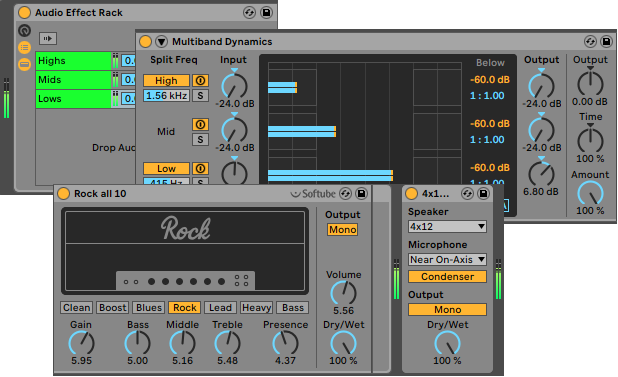Get cleaner guitar distortion, lusher chorusing, and super-special effects with multiband processing
Live’s Rack feature is ideal for building parallel effects, and the Multiband Dynamics processor makes it easy to do three-band processing. Fig. QQ shows an effect rack with three chains, for Highs, Mids, and Lows, with the rack followed by a speaker cabinet. The processors in each parallel chain are the same: Multiband Dynamics and Amp.
Figure 1 shows the Lows chain for multiband processing. However, all three chains are identical, except for some control settings (and optional tweaking to optimize the sound).

The Multiband Dynamics processor is the key to multiband operation. Set the compression ratio to 1:1.00 so that there’s no dynamics processing; this converts the processor into a three-band crossover. For the low chain (shown in the screen shot), choose your low and high split frequencies. I find that around 400 Hz and 1.2 kHz works well for guitar, but feel free to experiment. Then, turn down the Input and Output controls for the High and Mid bands. Now only the low frequencies will make it through the multiband dynamics to the amp.
Drag the same effects into the Mids chain, and turn down the Input and Output levels for the Low and High bands. Finally, drag the same effects into the Highs chain, and turn down the Input and Output levels for the Low and Mid bands.
Now you can solo each chain, and tweak the effects for the best blend of highs, mids, and lows. I often bump op the gain on the lows to create a bigger, beefier sound, and pull back gain on the highs so the high frequencies ring out brightly, instead of sounding harsh. Note that you need only one cabinet after all three chains; there’s a very small sonic benefit to including a cab in each chain, but it’s not really necessary.
Although this example uses distortion, there are also benefits to using multiband operation with chorusing, reverb (try different reverb sounds on the highs and mids, and no reverb on the lows), envelope filters, and even delay.
